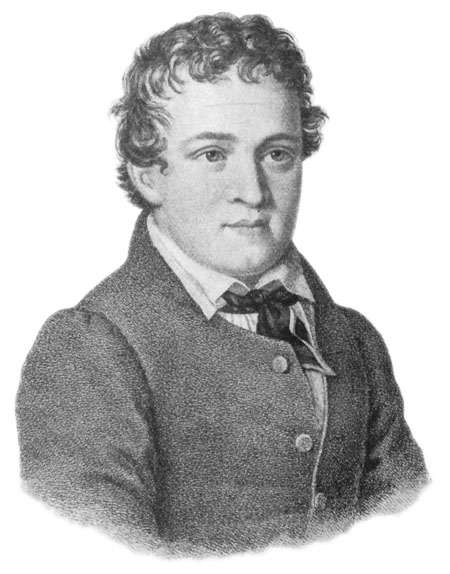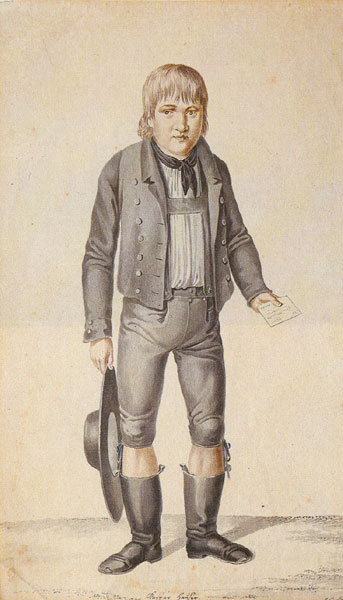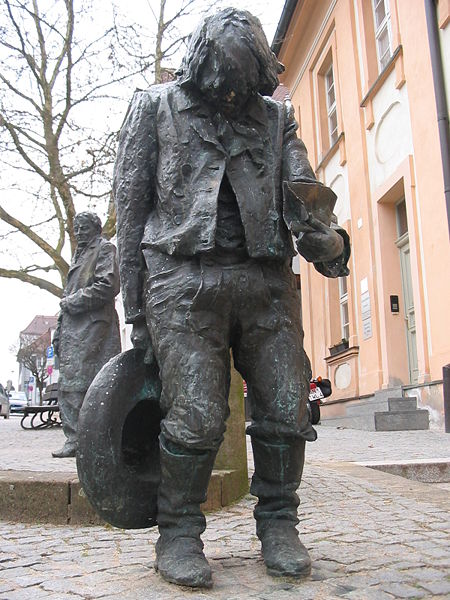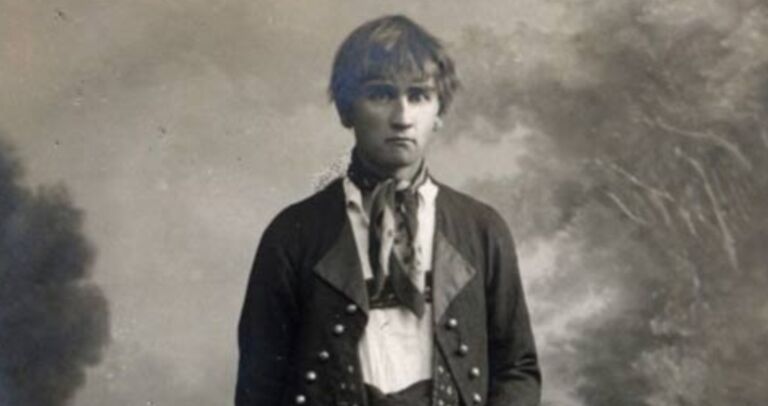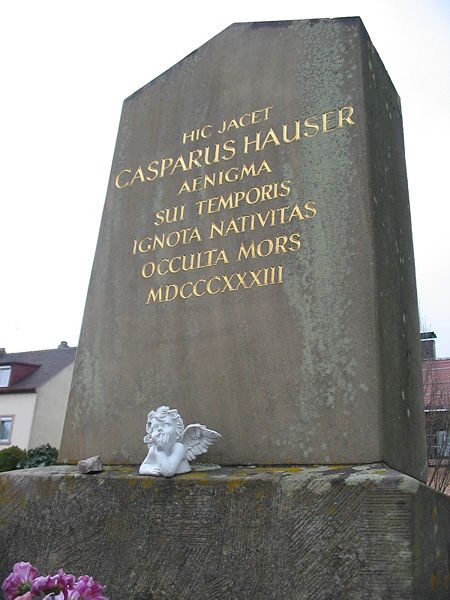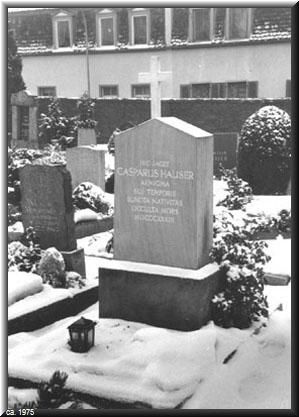On May 26, 1828, a teenage boy appeared in the streets of Nuremberg, Germany. He would barely talk, but he carried a letter with him addressed to the captain of the 4th squadron of the 6th cavalry regiment, Captain von Wessenig. The anonymous author said that the boy was given into his custody, as an infant, on the 7th October 1812, and that he had instructed him in reading, writing, and the Christian religion but had never let him "take a single step out of my house". The letter stated that the boy would now like to be a cavalryman; thus, the captain should take him in or hang him. There was another short letter enclosed, purporting to be from his mother to his prior caretaker. This letter was found to have been written by the same hand as the other one. It stated that he was born on April 30, 1812, and that his father, a cavalryman of the 6th regiment, was dead.
Shoemaker Weickmann took the boy to the house of Captain von Wessenig, where he would only repeat, "I want to be a cavalryman, as my father was," and "Horse! Horse!" Further demands elicited only tears, or the obstinate proclamation of "Don't know". He was taken to a police station, where he would write a name: Kaspar Hauser. He showed that he was familiar with money, could say some prayers, and read a bit, but he answered few questions, and his vocabulary appeared to be quite limited.
He spent the following two months in Vestner Gate Tower in the care of a jailor, Andreas Hiltel. Despite what many later accounts would say, he was in good physical condition and could walk well; for example, he climbed over ninety steps to his room. He was of a "healthy facial complexion"[2] and approximately sixteen years old, but appeared to be mentally retarded. Mayor Binder, however, claimed that the boy had an excellent memory and was learning quickly. Various curious people visited him, to his apparent delight. He refused all food except bread and water.
At first it was assumed that he had been raised like a half-wild human in forests, but during many conversations with Mayor Binder, Hauser told a different version of his past life, which he later also wrote down in more detail. According to this story he had, for as long as he could think back, spent his life always totally alone in a darkened cell about two meters long, one meter wide, and one and a half high, with only a straw bed to sleep on and a horse carved out of wood for a toy.
He claimed that he had found bread and water next to his bed each morning. Periodically the water would taste bitter, and had been apparently drugged: drinking this would cause him to sleep more heavily than usual, and when he had awakened his straw had been changed, and his hair and nails had been cut. Hauser claimed that the first human being he ever had had contact with had been a mysterious man who had visited him not long before his release, always taking great care not to reveal his face to him. This man, Hauser told, had taught him to write his name by leading his hand. After having learned to stand and to walk he had been brought next to Nuremberg. Furthermore, the stranger allegedly had taught him to say the phrase "I want to be a cavalryman, as my father was" (in Bavarian dialect), but Hauser claimed that he had not understood what these words meant.
This tale, still famous today, aroused great curiosity and made him an object of international attention. Rumors arose that he was of princely parentage, possibly of Baden origin, but there were also claims that he was an impostor. It is nowadays consensus among serious researchers that Hauser's account cannot possibly be true, or at least not taken literally.[3] As Psychiatrist Karl Leonhard explained: "If he had been living since childhood under the conditions he describes, he would not have developed beyond the condition of an idiot; indeed he would not have remained alive long. His tale is so full of absurdities that it is astonishing that it was ever believed and is even today still believed by many people."
Paul Johann Anselm Ritter of Feuerbach, president of the Bavarian court of appeals, began to investigate the case. Hauser was given to the care of Friedrich Daumer, a schoolmaster and speculative philosopher, who taught him various subjects and thereby discovered his talent for drawing. He appeared to flourish in this environment. Daumer also subjected him to homeopathic treatments and magnetic experiments. As Feuerbach told the story, "When Professor Daumer held the north pole towards him, Caspar put his hand to the pit of his stomach, and, drawing his waistcoat in an outward direction, said that it drew him thus; and that a current of air seemed to proceed from him. The south pole affected him less powerfully; and he said that it blew upon him."
On October 17, 1829, Hauser did not come to the midday meal, but was found bleeding from a cut wound on the forehead, in the cellar of Daumer's house. He asserted that while sitting on the privy he had been attacked and wounded by a hooded man who had also threatened him with the words: "You still have to die ere you leave the city of Nuremberg." Hauser said that by the voice he had recognized the man as the one who had brought him to Nuremberg. As was obvious from his blood trail, Hauser had at first fled to the first floor where his room was, but then instead of moving on to his caretakers, he had returned downstairs, and had climbed through a trap door into the cellar. Alarmed officials called for a police escort and transferred him to the care of Johann Biberbach, one of the municipal authorities. The alleged attack on Hauser also fueled rumors about his possible descent from the House of Baden. Hauser's critics are of the opinion that he had inflicted the wound on himself with a razor, which he then had brought back to his room before he betook himself to the cellar.[6] He might have done so to arouse pity and thus escape chiding for a recent quarrel with Daumer, who had come to believe that the boy had a tendency to lie.
On April 3, 1830, a pistol shot went off in Hauser's room at the Biberbachs' house. His escort hurriedly entered the room and found him bleeding from a wound to the right side of his head. Hauser quickly revived and stated that he had climbed on a chair to get some books, the chair had fallen, and while trying to hold on to something he had accidentally torn down the pistol hanging on the wall, causing the shot to go off. There are doubts whether the (benign) wound had actually been caused by the shot, and some authors associate the incident with a preceding quarrel where, again, Hauser had been reproached for lying.[8] In any case, the occurrence led the municipal authorities to come to another decision on Hauser, whose initially good relationship with the Biberbach family had soured. In May 1830, he was transferred to the house of Baron von Tucher,[9] who later also complained about Hauser's exorbitant vanity and lies. Perhaps the sharpest judgment passed on Hauser was the one by Mrs. Biberbach, who commented on his "horrendous mendacity", his "art of dissimulation", and called him "full of vanity and spite".
A British nobleman, Lord Stanhope, took an interest in Hauser and gained custody of him late in 1831. He spent a great deal to attempt to clarify Hauser's origin. In particular he paid for two visits to Hungary, as Hauser seemed to remember some Hungarian words. Stanhope later declared that the complete failure of these inquiries had led him to doubt Hauser's credibility. In December 1831, he transferred Hauser to Ansbach, to the care of a schoolmaster named Johann Georg Meyer, and in January 1832 Stanhope left Hauser for good. The lord continued to pay for Hauser's living expenses, but never made good on his promise that he would take him to England. After Hauser's death, Stanhope published a book in which he presented all known evidence against Hauser, taking it as his duty "to confess in public that I have been deceived."[11] Followers of Hauser suspect Stanhope of ulterior motives and connections to the House of Baden, but academic historiography defends him as a philanthropist, a pious man, and a seeker of truth.
Schoolmaster Meyer, strict and pedantic as he was, disliked Hauser's many excuses and apparent lies, and thus their relationship was quite strained. In late 1832, Hauser was given employment as a copier in the local law office. Still hoping that Stanhope would take him to England, he was much dissatisfied with his situation, which deteriorated further when his patron Anselm von Feuerbach died in May 1833. This certainly was a grievous loss to him.[13] (Some authors, however, point out that Feuerbach had, by the end of his life, apparently stopped believing in Hauser; at least he had written a note, to be found in his legacy, which read: "Caspar Hauser is a smart scheming codger, a rogue, a good-for-nothing that ought to be killed."
On December 9, 1833, Hauser had a serious argument with Meyer. Lord Stanhope was expected to visit Ansbach at Christmas, and Meyer said that he did not know how he would face him.
Five days later, on December 14, 1833, Hauser came home with a deep wound in his left breast. He said that he had been lured to the Ansbach Court Garden and that a stranger had stabbed him there while giving him a bag. When Policeman Herrlein searched the Court Garden he found a small violet purse containing a penciled note in "Spiegelschrift" (mirror writing). The message read, in German: "Hauser will be able to tell you quite precisely how I look and from where I am. To save Hauser the effort, I want to tell you myself from where I come _ _ . I come from from _ _ _ the Bavarian border _ _ On the river _ _ _ _ _ I even want to tell you the name: M. L. Ö." The wound in Hauser's chest proved to be fatal, and he died on December 17, 1833.
Inconsistencies in Hauser's account led the Ansbach court of enquiry to suspect that Hauser stabbed himself and invented a tale about being attacked. The note in the purse that was found in the Court Garden contained one spelling error and one grammatical error, both of which were typical for Hauser — who, on his deathbed, kept muttering incoherences about "writing with pencil." Although he had been very eager that the purse would be found, he did not ask for its contents. The note itself was folded in a specific triangular form — just the way Hauser used to fold his letters, according to Mrs. Meyer. Forensic doctors agreed that the wound could indeed be self-inflicted. Many authors[15] believe that he had wounded himself in a bid to revive public interest in his story and to convince Stanhope to fulfill his promise to take him to England, but that he stabbed himself more deeply than he had planned.
Kaspar Hauser was buried in a country graveyard; his headstone reads, "Here lies Kaspar Hauser, riddle of his time. His birth was unknown, his death mysterious." A monument to him was later erected in the Court Garden which reads Hic occultus occulto occisus est: "Here a mysterious one was killed in a mysterious manner."
On May 26, 1828, a teenage boy appeared in the streets of Nuremberg, Germany. He would barely talk, but he carried a letter with him addressed to the captain of the 4th squadron of the 6th cavalry regiment, Captain von Wessenig. The anonymous author said that the boy was given into his custody, as an infant, on the 7th October 1812, and that he had instructed him in reading, writing, and the Christian religion but had never let him "take a single step out of my house". The letter stated that the boy would now like to be a cavalryman; thus, the captain should take him in or hang him. There was another short letter enclosed, purporting to be from his mother to his prior caretaker. This letter was found to have been written by the same hand as the other one. It stated that he was born on April 30, 1812, and that his father, a cavalryman of the 6th regiment, was dead.
Shoemaker Weickmann took the boy to the house of Captain von Wessenig, where he would only repeat, "I want to be a cavalryman, as my father was," and "Horse! Horse!" Further demands elicited only tears, or the obstinate proclamation of "Don't know". He was taken to a police station, where he would write a name: Kaspar Hauser. He showed that he was familiar with money, could say some prayers, and read a bit, but he answered few questions, and his vocabulary appeared to be quite limited.
He spent the following two months in Vestner Gate Tower in the care of a jailor, Andreas Hiltel. Despite what many later accounts would say, he was in good physical condition and could walk well; for example, he climbed over ninety steps to his room. He was of a "healthy facial complexion"[2] and approximately sixteen years old, but appeared to be mentally retarded. Mayor Binder, however, claimed that the boy had an excellent memory and was learning quickly. Various curious people visited him, to his apparent delight. He refused all food except bread and water.
At first it was assumed that he had been raised like a half-wild human in forests, but during many conversations with Mayor Binder, Hauser told a different version of his past life, which he later also wrote down in more detail. According to this story he had, for as long as he could think back, spent his life always totally alone in a darkened cell about two meters long, one meter wide, and one and a half high, with only a straw bed to sleep on and a horse carved out of wood for a toy.
He claimed that he had found bread and water next to his bed each morning. Periodically the water would taste bitter, and had been apparently drugged: drinking this would cause him to sleep more heavily than usual, and when he had awakened his straw had been changed, and his hair and nails had been cut. Hauser claimed that the first human being he ever had had contact with had been a mysterious man who had visited him not long before his release, always taking great care not to reveal his face to him. This man, Hauser told, had taught him to write his name by leading his hand. After having learned to stand and to walk he had been brought next to Nuremberg. Furthermore, the stranger allegedly had taught him to say the phrase "I want to be a cavalryman, as my father was" (in Bavarian dialect), but Hauser claimed that he had not understood what these words meant.
This tale, still famous today, aroused great curiosity and made him an object of international attention. Rumors arose that he was of princely parentage, possibly of Baden origin, but there were also claims that he was an impostor. It is nowadays consensus among serious researchers that Hauser's account cannot possibly be true, or at least not taken literally.[3] As Psychiatrist Karl Leonhard explained: "If he had been living since childhood under the conditions he describes, he would not have developed beyond the condition of an idiot; indeed he would not have remained alive long. His tale is so full of absurdities that it is astonishing that it was ever believed and is even today still believed by many people."
Paul Johann Anselm Ritter of Feuerbach, president of the Bavarian court of appeals, began to investigate the case. Hauser was given to the care of Friedrich Daumer, a schoolmaster and speculative philosopher, who taught him various subjects and thereby discovered his talent for drawing. He appeared to flourish in this environment. Daumer also subjected him to homeopathic treatments and magnetic experiments. As Feuerbach told the story, "When Professor Daumer held the north pole towards him, Caspar put his hand to the pit of his stomach, and, drawing his waistcoat in an outward direction, said that it drew him thus; and that a current of air seemed to proceed from him. The south pole affected him less powerfully; and he said that it blew upon him."
On October 17, 1829, Hauser did not come to the midday meal, but was found bleeding from a cut wound on the forehead, in the cellar of Daumer's house. He asserted that while sitting on the privy he had been attacked and wounded by a hooded man who had also threatened him with the words: "You still have to die ere you leave the city of Nuremberg." Hauser said that by the voice he had recognized the man as the one who had brought him to Nuremberg. As was obvious from his blood trail, Hauser had at first fled to the first floor where his room was, but then instead of moving on to his caretakers, he had returned downstairs, and had climbed through a trap door into the cellar. Alarmed officials called for a police escort and transferred him to the care of Johann Biberbach, one of the municipal authorities. The alleged attack on Hauser also fueled rumors about his possible descent from the House of Baden. Hauser's critics are of the opinion that he had inflicted the wound on himself with a razor, which he then had brought back to his room before he betook himself to the cellar.[6] He might have done so to arouse pity and thus escape chiding for a recent quarrel with Daumer, who had come to believe that the boy had a tendency to lie.
On April 3, 1830, a pistol shot went off in Hauser's room at the Biberbachs' house. His escort hurriedly entered the room and found him bleeding from a wound to the right side of his head. Hauser quickly revived and stated that he had climbed on a chair to get some books, the chair had fallen, and while trying to hold on to something he had accidentally torn down the pistol hanging on the wall, causing the shot to go off. There are doubts whether the (benign) wound had actually been caused by the shot, and some authors associate the incident with a preceding quarrel where, again, Hauser had been reproached for lying.[8] In any case, the occurrence led the municipal authorities to come to another decision on Hauser, whose initially good relationship with the Biberbach family had soured. In May 1830, he was transferred to the house of Baron von Tucher,[9] who later also complained about Hauser's exorbitant vanity and lies. Perhaps the sharpest judgment passed on Hauser was the one by Mrs. Biberbach, who commented on his "horrendous mendacity", his "art of dissimulation", and called him "full of vanity and spite".
A British nobleman, Lord Stanhope, took an interest in Hauser and gained custody of him late in 1831. He spent a great deal to attempt to clarify Hauser's origin. In particular he paid for two visits to Hungary, as Hauser seemed to remember some Hungarian words. Stanhope later declared that the complete failure of these inquiries had led him to doubt Hauser's credibility. In December 1831, he transferred Hauser to Ansbach, to the care of a schoolmaster named Johann Georg Meyer, and in January 1832 Stanhope left Hauser for good. The lord continued to pay for Hauser's living expenses, but never made good on his promise that he would take him to England. After Hauser's death, Stanhope published a book in which he presented all known evidence against Hauser, taking it as his duty "to confess in public that I have been deceived."[11] Followers of Hauser suspect Stanhope of ulterior motives and connections to the House of Baden, but academic historiography defends him as a philanthropist, a pious man, and a seeker of truth.
Schoolmaster Meyer, strict and pedantic as he was, disliked Hauser's many excuses and apparent lies, and thus their relationship was quite strained. In late 1832, Hauser was given employment as a copier in the local law office. Still hoping that Stanhope would take him to England, he was much dissatisfied with his situation, which deteriorated further when his patron Anselm von Feuerbach died in May 1833. This certainly was a grievous loss to him.[13] (Some authors, however, point out that Feuerbach had, by the end of his life, apparently stopped believing in Hauser; at least he had written a note, to be found in his legacy, which read: "Caspar Hauser is a smart scheming codger, a rogue, a good-for-nothing that ought to be killed."
On December 9, 1833, Hauser had a serious argument with Meyer. Lord Stanhope was expected to visit Ansbach at Christmas, and Meyer said that he did not know how he would face him.
Five days later, on December 14, 1833, Hauser came home with a deep wound in his left breast. He said that he had been lured to the Ansbach Court Garden and that a stranger had stabbed him there while giving him a bag. When Policeman Herrlein searched the Court Garden he found a small violet purse containing a penciled note in "Spiegelschrift" (mirror writing). The message read, in German: "Hauser will be able to tell you quite precisely how I look and from where I am. To save Hauser the effort, I want to tell you myself from where I come _ _ . I come from from _ _ _ the Bavarian border _ _ On the river _ _ _ _ _ I even want to tell you the name: M. L. Ö." The wound in Hauser's chest proved to be fatal, and he died on December 17, 1833.
Inconsistencies in Hauser's account led the Ansbach court of enquiry to suspect that Hauser stabbed himself and invented a tale about being attacked. The note in the purse that was found in the Court Garden contained one spelling error and one grammatical error, both of which were typical for Hauser — who, on his deathbed, kept muttering incoherences about "writing with pencil." Although he had been very eager that the purse would be found, he did not ask for its contents. The note itself was folded in a specific triangular form — just the way Hauser used to fold his letters, according to Mrs. Meyer. Forensic doctors agreed that the wound could indeed be self-inflicted. Many authors[15] believe that he had wounded himself in a bid to revive public interest in his story and to convince Stanhope to fulfill his promise to take him to England, but that he stabbed himself more deeply than he had planned.
Kaspar Hauser was buried in a country graveyard; his headstone reads, "Here lies Kaspar Hauser, riddle of his time. His birth was unknown, his death mysterious." A monument to him was later erected in the Court Garden which reads Hic occultus occulto occisus est: "Here a mysterious one was killed in a mysterious manner."
Advertisement
Explore more
Sponsored by Ancestry
Advertisement


